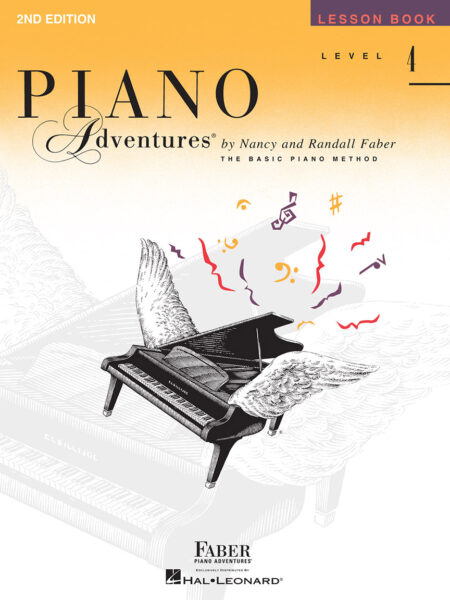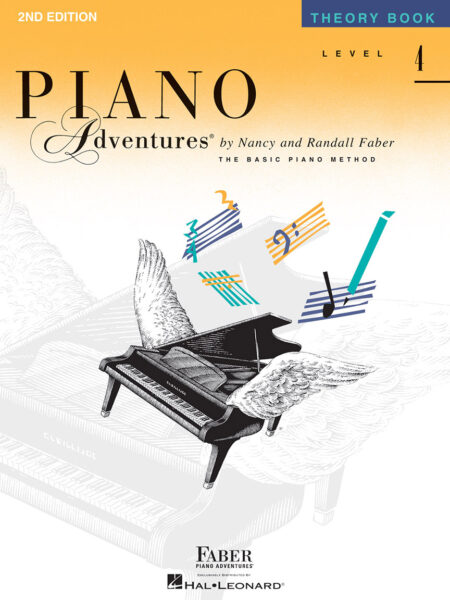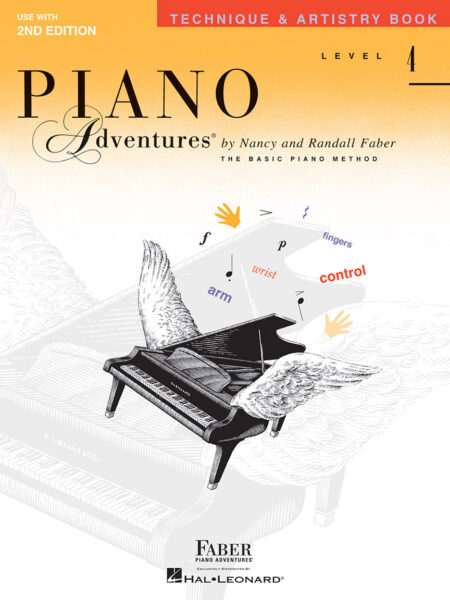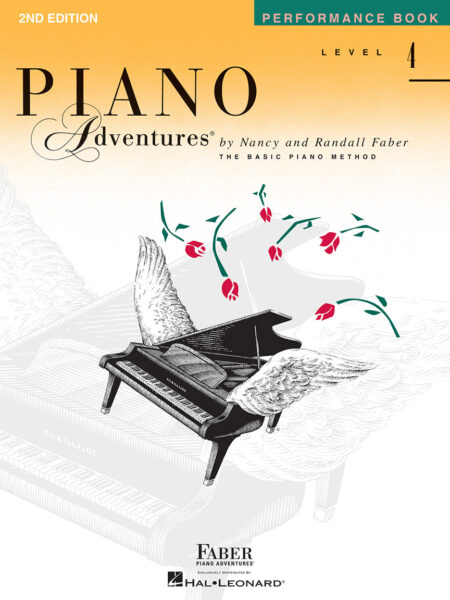
20Questions and Answers for Level 4
About the Level 4 Books
- The Level 4 Lesson Book starts with a Level 3B Review, “Get Ready for Take-off!” Is this important to do?
- Should I use all four core Level 3A Books: Lesson, Theory, Technique & Artistry, and Performance?
- How do I fit all four Level 4 core books into a lesson?
- Level 4 introduces the V7 chord in root position. How is this taught and reinforced?
- How is the LH developed at Level 4?
- Do you recommend transposing pieces at Level 4?
- What are the Level 4 Technique Secrets and how do they help?
- When should I begin using the Level 4 Sightreading Book and how?
About the Level 4 Student
- Are there any student-student duets at Level 4?
- Should students memorize the sharp pattern? How fast should they be able to write key signatures? (p. 38)
- How important is it to have students memorize Level 4 pieces?
- Where can I find more lead sheets for the Level 4 student?
- When can a student begin a Literature Book in Level 4? Which level of the series should I use?
- What pieces could a Level 4 student play for extra fun?
- Do Level 4 students compose and improvise?
- What if the student plays sports, also plays a second instrument, has little time to practice—but likes the piano?
- Could a Level 4 student start teaching piano as a teacher’s assistant?
- Can I teach Level 4 students in an online lesson? What are some teaching tips?
About the Level 4 Adventure Learning Videos
About the Level 4 Audio Files
1. The Level 4 Lesson Book starts with a Level 3B Review, “Get Ready for Take-off!” Is this important to do?
The Level 3B Review that begins Level 4 is a handy teacher assessment tool. Use it for students graduating to Level 4 as well as transfer students. The Level 3B Review helps the teacher assess what is understood and what needs more support.
Rhythm review includes metric counting (1 e + a) of 16th-note patterns. Reading review covers naming intervals (2nd, 3rd, 4th, 5th, 6th, 7th, octave), and key signatures. Theory review includes major scales, relative natural/harmonic minor scales, and various symbols and terms.
Areas in which the student lacks confidence allow the teacher to “review and renew” understanding. Explore board work and give cheerful explanations of concepts, along with investigative questions, to review concepts together. Consider using the 3B Sightreading Book for students who need a reading boost. This will help them develop faster recognition of chords, intervals, and rhythm patterns for success in Level 4.
Level 4 Lesson Book
Get Ready for Take-off! (Level 3B Review, pp. 4-5)
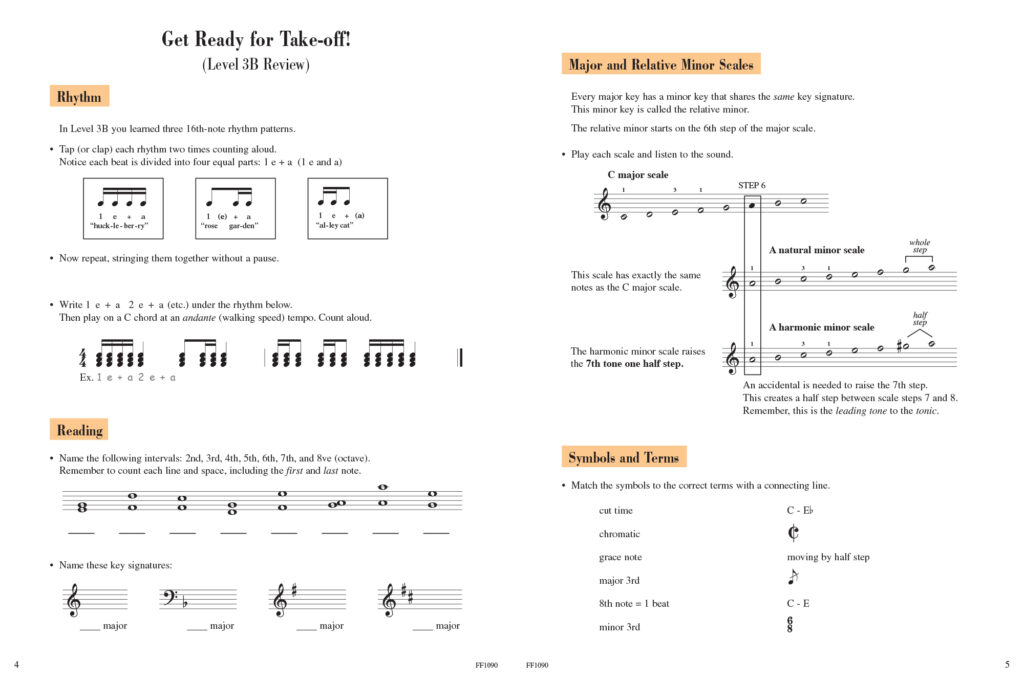
2. Should I use all four core Level 3A Books: Lesson, Theory, Technique & Artistry, and Performance?
The four core Level 4 Books form a set for wholistic learning and correlate by page number. The Theory, Technique & Artistry, and Performance Books give fresh perspectives for concepts in the Level 4 Lesson Book. It is possible a teacher could substitute a different solo book than the Performance Book. However, the precise tie-in of concepts in the core books is hard to beat. The intermediate student continues to make connections—connections that form the “musical mind”—and the more efficient these connections are made the better.
The core books address things easy to miss in lessons: ear-training, sightreading, improvisation, and importantly, building excellent technique for the intermediate student. Taking the time for deeper learning using the four core Level 4 Books prepares students for success in Level 5.
3. How do I fit all four Level 4 core books into a lesson?
The three most important books are the Lesson Book, the Theory Book, and the Technique & Artistry Book. A 45-minute lesson or one-hour lesson is highly recommended for the Level 4 student, offering a distinct time advantage for using all four books.
If time is short, consider demonstrating the Performance Book piece while the student watches the music. Give a few pointers, then assign to learn at home as your own “adventure piece.” This gives the teacher an opportunity to see what is easy and what is challenging at the next lesson.
For the Theory Book, the teacher might do the first example on a page with the student, then assign to complete at home. With careful lesson planning and efficient use of lesson time, the four books can be implemented, even if one book is not covered in some lessons.
4. Level 4 introduces the V7 chord in root position. How is this taught and reinforced?
Pedagogy of the V7 Chord:
In Level 1: The two-note V7 chord is taught.
In Level 2A: The two-note V7 is played in multiple keys.
In Level 2B: The 3-note V7 is taught. The student can learn the V7 chord in all 12 keys.
In Level 4: The 4-note V7 in root position is taught. With a LH warm-up that features “theory lyrics,” the exercise builds understanding of the root position V7 chord through scale steps and chord tones. It can be transposed to many keys.
Level 4 Lesson Book
Key of C: V7 Chord in Root Position (p. 10)

- First, the exercise sets 4 steady beats on the I chord. It then steps up 5 notes to the dominant, then drops down an octave to the dominant. Teachers can emphasize that the dominant occurs in music above and below the tonic note.
- The exercise moves to the broken V chord with words, “root-3rd-5th.”
- From the V chord, the exercise moves to a broken root position V7 chord with words, “root-3rd-5th-7th.”
- In music this 4-note V7 chord often has a note missing for a more elegant sound. The exercise ends with a 3-note root position V7 that has a missing 3rd, then a missing 5th, and finally, a 2-note V7 chord “shell” (interval of a 7th).
This exercise appears throughout the book in various keys. It’s recommended that students memorize this “V7 training tune” and play it as a warm-up for other pieces as well.
Sample root position V7 intros:
Level 4 Lesson Book
In the Hall of the Mountain King (key of Am: V7 in root position, p. 12)

Mazurka in F (key of F: V7 in root position, p. 22)

The Spy (key of D minor: V7 in root position, p. 24)

Grand Central Station (key of G: V7 in root position, p. 30)
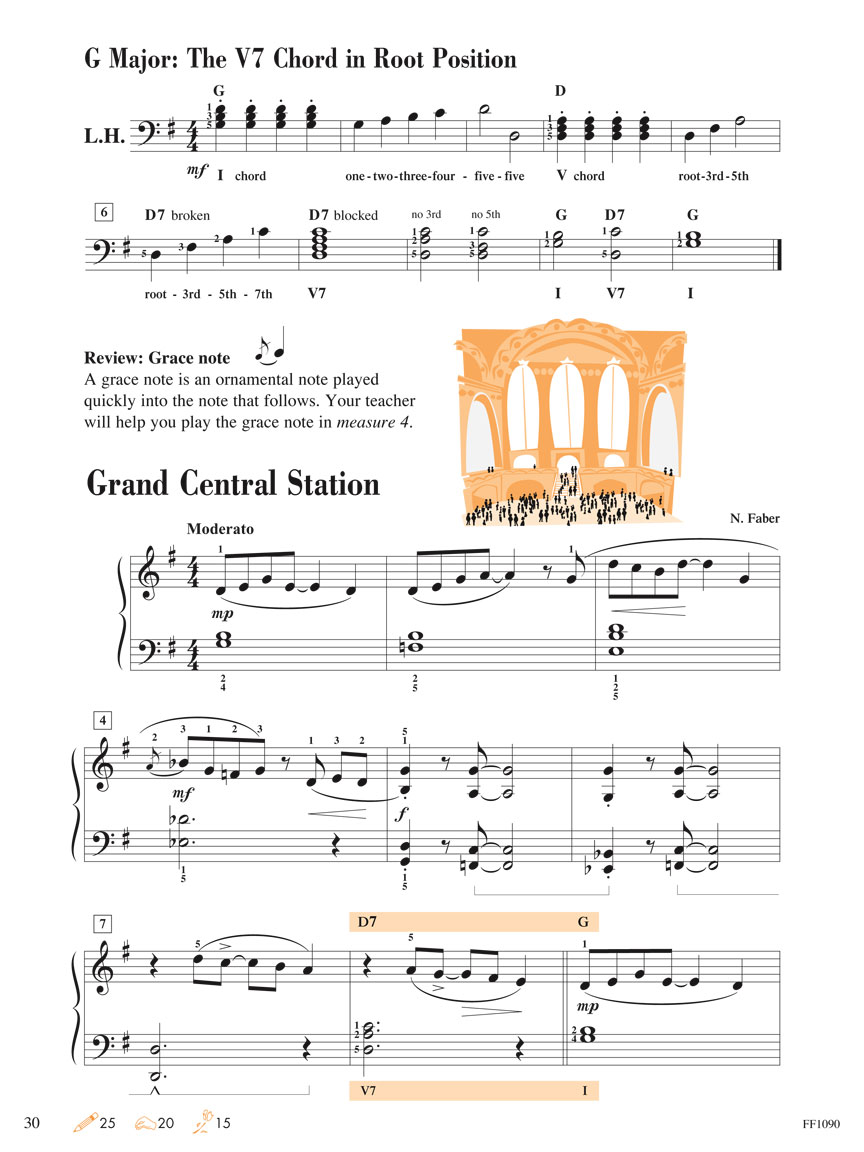
Volga Boatmen (key of Em: V7 in root position, p. 32)
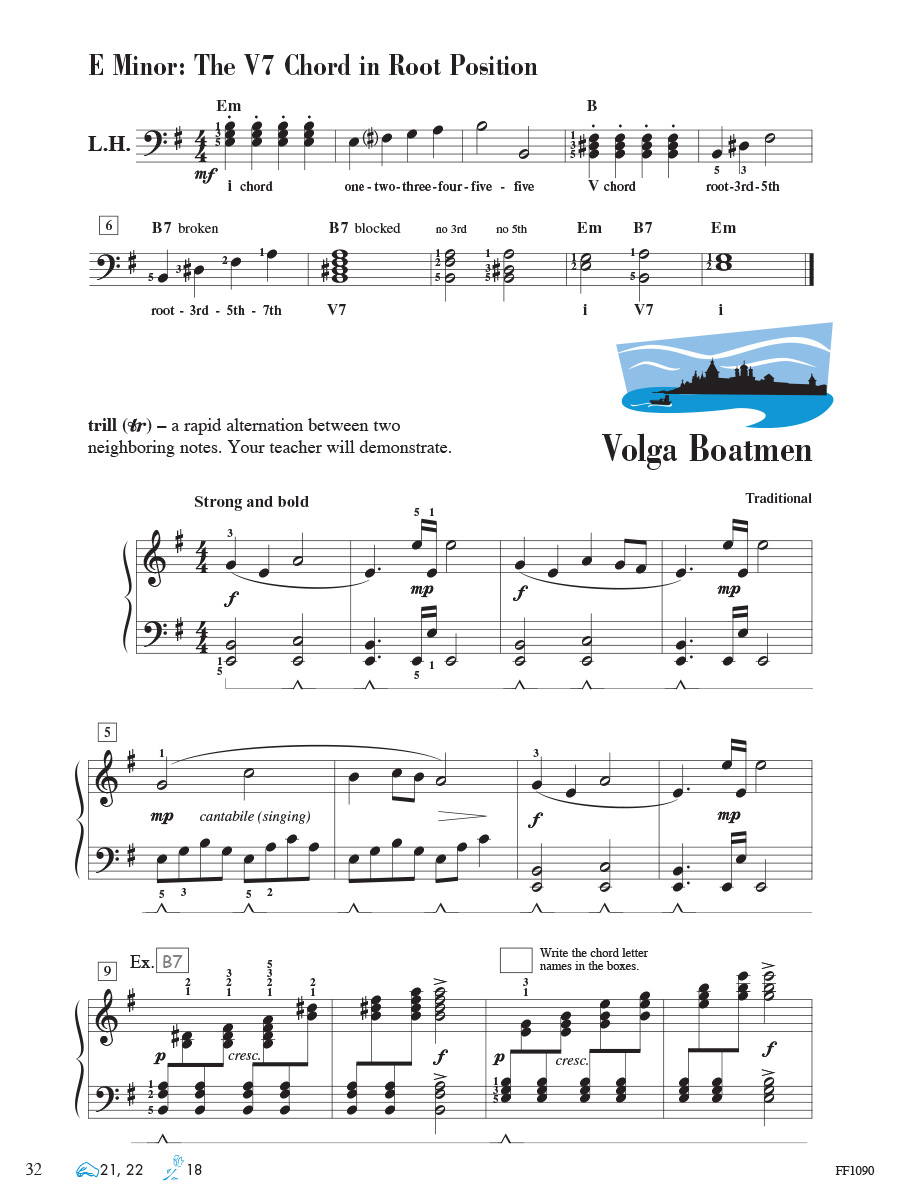
5. How is the LH developed at Level 4?
Left hand development expands at Level 4 with two-octave 16th-note scales, root position V7 chords, LH octaves (blocked and broken), wide LH accompaniment gestures, and fast LH 16th-note passages.
Level 4 Lesson Book
Level 4 Power Scales (16th-note scales, p. 8)

Chanson (wide LH gestures, p. 35)

Great Barrier Reef (LH octaves, pp. 50-51)

Level 4 Technique & Artistry Book: broken octaves, LH solo using chord inversions, 16-note passages
Octave March 2 (broken octaves, p. 33)

LH Virtuoso Chord Patterns (LH chord inversions, p. 16)

Return of the Scale Monster (LH scale passages, pp. 30-31)

LH Finger Races (LH 16th-note patterns, pp. 36-37)

6. Do you recommend transposing pieces at Level 4?
At Level 4 transposing becomes increasingly challenging. Students will need to pay close attention to starting positions. For instance, does the RH start on the 3rd note of the scale or the 5th? Transposition brings musical challenges with finger substitutions, shifting chords, and use of octaves. Using the “ear,” thinking intervals, and relating tonic, dominant, and leading tone all bring these important theory skills to a higher level.
An entire song, or just a portion of a piece can be transposed. Students become “keyboard smart” with short transposition workouts.
Level 4 Lesson Book
In the Hall of the Mountain King (transpose measures 1-9 to Dm, pp. 12-13)

Volga Boatmen (transpose measures 1-8 to Am, Dm, p. 32)

Gigue in A Major (transpose measures 1-8 to G, p. 48)

7. What are the Level 4 Technique Secrets and how do they help?
Technique at the piano requires more than finger muscles. It involves sophisticated body motion between the body, arm, wrist, and finger. We call these motions “technique gestures.”
At each level of Piano Adventures, the student is introduced to level-appropriate Technique Secrets that promote fluent playing while preventing bad habits. These “secrets” are used as daily warm-ups for the exercises that follow in the book. This combination of secrets and exercises leads to an Artistry Magic Piece at the end of each unit. These pieces allow the intermediate student to demonstrate artistry based on fine technique learned earlier.
Level 4 Technique & Artistry has 4 Technique Secrets, each with a unique name.
- Alignment (Balance Beam)
- Drop and Follow-Through (Spark the Pattern)
- Weighted Tone and Empty Fingers (Tonal Colors)
- Half Circle/Full Circle (Lead with the Wrist)
Check out sample videos of Technique Secrets here.
Level 4 Technique & Artistry
Level 4 Technique Secrets (pp. 2-3)

8. When should I begin using the Level 4 Sightreading Book and how?
The Level 4 Sightreading Book builds confident intermediate readers in two ways: recognition of individual notes and perception of rhythmic and melodic patterns.
The book is organized into sets of 5 exercises, for 5 days of practice. Each set presents variations on a piece from the Level 4 Lesson Book. Play one exercise a day, completing one set per week.
Students may begin the Level 4 Sightreading Book with the first piece in the Level 4 Lesson Book, “Aurora Borealis.” Integrating sightreading as the student’s skill expands builds on this important principle: Notes and chords that do not change their location on the staff are integrated into compositional patterns that do change. Permanence and change come together for musical literacy.
Here are several ways to use the Level 4 Sightreading Book.
- Teachers listen to the sightreading example for just “Day 1” at the lesson. Assign the next pages of the 5-day set to sightread at home. At the following lesson, the teacher might choose one sample “Day” from that set to hear. Then assign the next set.
- If teaching 30-minute lessons, teachers might consider using the Sightreading Book in place of the Performance Book.
- Some teachers enjoy using the Sightreading Book at the lesson to introduce a piece. The student then learns the correlating Lesson Book piece at home as an independent study.
- The Sightreading Book can be used as a final end-of-level project. Before starting Level 5, take several weeks to assign multiple pages of the 3B Sightreading Book, supported with a BigTime Book. Students can enjoy a change of pace in their practice routine, while celebrating all the keys, chords, and rhythms they have learned.
Level 4 Sightreading Book
Table of Contents (pp. 2-3)

Aurora Borealis (pp. 6-9)


About the Level 4 Student
9. Are there any student-student duets at Level 4?
A student-student duet can be found in the Level 4 Performance Book.
In addition, there are several duets in the Developing Artist Literature Books 1, 2, and 3 that could be of interest for Level 4 students. (See below.)
Lastly, most Level 4 students will be able to play a Teacher Duet from the PreTime, PlayTime, or ShowTime books with a younger sibling or other student in these earlier levels.
Level 4 Performance Book
(This piece is also in Piano Literature Book 2.)
Polka (student-student duet, by Hummel, pp. 10-11)

There are also duets in the Developing Artist Literature Books: Preparatory, 1, 2, and 3 that could be accessible for 3B students.
Preparatory Piano Literature
Melody (Beyer, pp. 14-15)

Piano Literature Book 1
Waltz for Four Hands (Wohlfahrt, pp. 24-25)

Piano Literature Book 2
Polka (Hummel, pp. 24-25)

Piano Literature Book 3
Rondo for Four Hands (Diabelli, pp. 40-45)



Lastly, most Level 4 students will be able to play a Teacher Duet from the PreTime, PlayTime, or ShowTime Books with a sibling or younger student in that level.
10. Should students memorize the sharp pattern? How fast should they be able to write key signatures? (p. 38)
Yes, students should memorize the sharp pattern and write it regularly during Level 4 (and Level 5) to make it part of their theory “toolkit.” Memorization may include a quirky sentence like, “Francis Can Go Down And Eat B![]() —C
—C![]() — G
— G![]() — D
— D![]() — A
— A![]() — E
— E![]() — B
— B![]()
Along with writing the pattern in both clefs, practice writing sharp key signatures on staff paper or on a board. If students are adept at sharp scales, their memory of the scale will help to write its key signature. Otherwise, a good rule is to begin writing the sharp pattern: F![]() — C
— C![]() — G
— G![]() — D
— D![]() — A
— A![]() — E
— E![]() — B
— B![]() and write up to the sharp that is just before the name of the key.
and write up to the sharp that is just before the name of the key.
For the key of D, for instance, students would begin the pattern and write up to C![]() (the letter name before D). For the key of B, students would begin the pattern and write up to A
(the letter name before D). For the key of B, students would begin the pattern and write up to A![]() , etc.
, etc.
Level 4 Lesson Book
Sharp Key Signatures (p. 38)

11. How important is it to have students memorize Level 4 pieces?
This is an interesting question. Ideally, memorization begins very early in piano study, even at the Primer Level. A student memorizes a piece every week. The ease of memorizing these very short pieces brings skill and confidence in memorizing.
A student who has not memorized prior to this point will probably find it more challenging to memorize Level 4 and other piano literature pieces.
Basic thoughts about memorizing:
- All memorization is good for a student’s musical mind.
- Every piece does not need to be memorized, of course. However, a student can be expected to play the opening section by memory. Or the opening theme. Or even just the Coda!
- Always build memory capacity even through small assignments.
- Understanding the musical form of a piece is always an aid to memory. The ability to “Start at the B section with your RH on the dominant,” for instance, gives remarkable security.
- Memorizing the LH alone for a bass line allows the student to scrutinize the intervals. This will be very helpful in playing hands together by memory.
- Consider having what might be called memory “pegs” in each piece. These are spots where a student can begin “cold,” without hesitation. A peg can be the beginning of a section, a phrase, or really anywhere the student chooses. In a performance, should it become necessary, the student can simply jump to a “peg” and be on their way.
- Once a student has memorized a piece, celebrate the success and play the piece(s) often at next lessons.
Most students enjoy having the teacher sit on a couch or chair, away from the piano, to approximate a true performance space. Listen to the student’s performance of memorized pieces letting them command the space!
Consider also ending a lesson using this “mock performance space.” The student might play a well-prepared piece from Level 4 using the music. Then close with a memorized piece for a special achievement.
12. Where can I find more lead sheets for the Level 4 student?
Lead sheets are one of the best ways ever to actively apply the theory of major and minor chords, learn to create with different accompaniment patterns, and be able to play scores of songs.
Level 4 Lesson Book
The Blue Danube (lead sheet, pp. 44-45)

More Level 4 lead sheets for download are coming soon.
13. When can a student begin a Literature Book in Level 4? Which level of the series should I use?
At Level 4, a student could start Piano Literature Book 2 or Piano Literature Book 3 at Level 4. The teacher can determine the best choice depending on the student’s interest and ability.
Making musical connections between the Literature pieces and the Method pieces can be quite helpful in teaching. It gives teachers the opportunity for “musical chats” with the student—to compare form, keys, harmony, accompaniment patterns, and phrasing. Level 4. The teacher can determine the best choice depending on the student’s interest and ability.

14. What pieces could a Level 4 student play for extra fun?
For extra Level 4 fun, BigTime Piano Books offer a variety of styles with many familiar songs.

The name “BigTime” represents three musical outcomes:
- A “big” sound at the keyboard, bigger pieces, and faster tempi.
- A bigger harmonic palette, with chord symbols shown for some styles.
- A big arrival point after 5 earlier levels: PreTime, PlayTime, ShowTime, ChordTime, and FunTime.
Many students can start a BigTime Book as early as Unit 2 in the Level 4 Lesson Book. The following keys have been covered: C major and A minor, G major and E minor, F major and D minor, and D major. 16th-note patterns have been presented. And importantly, the V7 chord in root position has been introduced.
Here are a few favorites.
BigTime Disney Book
Beauty and the Beast (pp. 40-41)

BigTime Rock ’n Roll Book
Rock Around the Clock (pp. 4-5)

BigTime Christmas Book
Winter Wonderland (pp. 35-36)


BigTime Kids’ Songs Book
The Pink Panther (pp. 18-19)

15. Do Level 4 students compose and improvise?
There are many opportunities to compose and improvise in Level 4. These activities are integrated throughout the level and bring support to new keys and chords being learned.
In the Level 4 Lesson Book, students begin to improvise in major and minor keys using major and relative minor scales. They also learn “improv duet parts.” In this way, students take on the role of “teacher” and can provide the harmonic background to play with another student, parent, or friend.
Level 4 Theory Book
Improvise in C Major and A minor (p. 3)

Composing with Sequences (p. 10)

Improvise in F Major and D minor (p. 15)

Improvise in G Major and E minor (p. 23)

Minor-Major Waltz (pp. 26-27)

Improvise in D Major and A Major (p. 33)

16. What if the student plays sports, also plays a second instrument, has little time to practice—but likes the piano?
This busy student is not uncommon. The key ingredient is “likes the piano.”
The teacher is in a unique position to teach lessons in a slightly different way. In large part, our role as piano teachers is to create the future music lovers of society—the young adults who will support the arts in the future, attend concerts, sing in a church choir, etc.
Consider the following paths for this busy student:
- Give fewer pieces, even just two that the student really likes, along with some scales. Use lesson time to analyze the harmony of these pieces, practice memorizing, and discuss interesting facts about the composer, if applicable.
- If the student is in Level 4, consider using a FunTime (Level 3A-3B) piece that the student really enjoys along with a Level 4 piece.
- Use the improvisation pages from the Level 4 Theory Book. This can open creativity in ways that doesn’t involve practice. (See Question 15)
Engage personally with the student to be an ally for their activities, plans, and general love of music.

17. Could a Level 4 student start teaching piano as a teacher’s assistant?
This is an interesting concept—a Level 4 student can be a practice partner for a younger student! Particularly with Zoom lessons available in most households, a younger student is usually thrilled to have an older student “mentor” them—hear their pieces, joke around a bit, and receive encouragement with an online “playdate.”
Even if only 15 minutes once or twice a week, it gives the Level 4 student a chance to “give back,” builds on the idea of service, and usually benefits the Level 4 student in unexpected ways, not to mention the 2A student. The long-term result may be a future piano teacher in the making!

18. Can I teach Level 4 students in an online lesson? What are some teaching tips?
Yes, it is completely possible to teach Level 4 books in an online lesson, such as Zoom.
The best way to do this is through subscribing to the Teacher Atlas and using its screen-sharing capability. All books in the Faber Library are available for viewing and screen sharing—including the Level 4 method books and the supplementary BigTime Piano Books.
Here are some ideas for teaching the Level 4 Lesson Book in an online lesson.
NOTE: Have the student become very familiar with the music before playing. Accomplish this through questions that require active responses from the student. Keep the discussion light, upbeat, and “congratulatory” as the student answers.
Let’s apply this to the Level 4 Review Piece, “Aurora Borealis.” These are sample ideas. Teachers can create original questions and responses.
Level 4 Lesson Book
Aurora Borealis (p. 6)
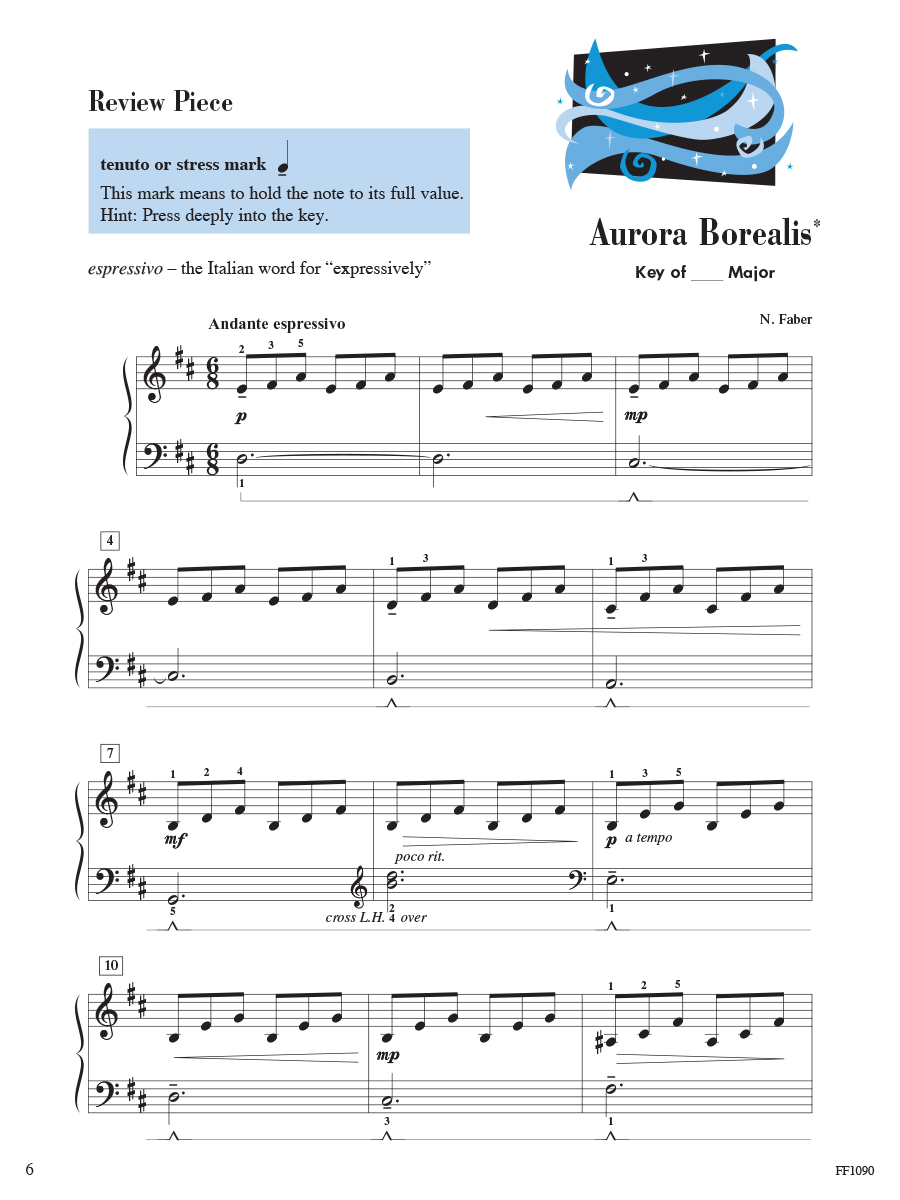
Sample Online Questions for “Aurora Borealis”
- What is the title of this piece?
“Yes, Aurora Borealis.”
- Will you read the text for “Aurora Borealis” on the top of p. 2? “Good.” (The paragraph describes colorful light spreading across the sky. The music imitates this idea.)
- Back to p. 1. Let’s name the key.
“Right—D major.”
- Will you define the time signature? What does 6/8 mean?
“Yes, 6 beats to a measure, and the 8th notes get 1 beat.”
- I’d like to start by playing the first measures of the LH. Notice the descending bass line that follows with a LH crossover into the Treble Clef. For now, I’ll just play the notes freely without counting the ties. (Play, saying “D, C
 , B, A, G—and here’s my crossover to B-D in the treble clef.
, B, A, G—and here’s my crossover to B-D in the treble clef.
“Your turn to try these LH notes. Good work!”
- Now, continue to play just your LH. The hand begins newly on the E. I have to warn you. There are 2 sharps in the next bit of music. See if you can catch them and look sharp for the crossover, too!
(Student plays.) “Good work!”
- Carry on in this way to the end for the LH notes.
- Let’s look at the RH. The rhythm is a steady stream of expressive, flowing 8th notes. Would you read the information in the blue box on page 1?
“Yes, tenuto mark. Even the first RH note has a tenuto mark. So we’ll press it just a bit more.”
- I’d like you to carefully watch the music as I demonstrate the piece. (Do)
- Now let’s be adventurous and you can play both hands together, slowly.
Also use the pedal for the dreamy, nighttime effect.
“Very good reading.”
- Two quick theory questions to end.
Look at p. 2. Which two measures have a B major broken chord?
“Great! Measures 15-16.”
Name the 2 notes used in the last two measures.
“That’s right. F and C
and C .”
.”
- This week when you practice, play slowly and expressively. Use the crescendos and diminuendos to create more color. And don’t forget to enjoy the sounds you create!
About the Level 4 Adventure Learning Videos
19. What are the Adventure Learning Videos
These videos feature close-ups of the hands with simple text that taps the student’s “musical mind” with theory analysis and technique tips.
The Adventure Learning Videos for Level 2B are currently in progress and should be completed at the end of 2022. They can be very useful in a variety of ways and are modeled after the Primer Adventure Learning Videos.

About the Level 4 Audio Files
20. What are the audio files and how should I use them?
We are keen on continuing to add more audio support. While we prepare Level 4 method audio files, please enjoy the Classics, Popular, Christmas and Hits content at Level 4 inside the Piano Adventures Player app, and the BigTime Piano Christmas accompaniments available in the Audio Cloud.
In addition, Level 4 Technique & Artistry performance demonstrations are available in video format inside our Technique & Artistry Online platform. It’s included with a Teacher Atlas membership or standalone Faber Technique & Artistry plan.


